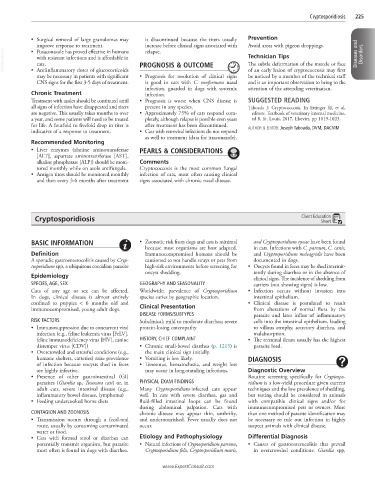Page 499 - Cote clinical veterinary advisor dogs and cats 4th
P. 499
Cryptosporidiosis 225
• Surgical removal of large granulomas may is discontinued because the titers usually Prevention
improve response to treatment. increase before clinical signs associated with Avoid areas with pigeon droppings.
VetBooks.ir with resistant infections and is affordable in PROGNOSIS & OUTCOME Technician Tips Diseases and Disorders
relapse.
• Posaconazole has proved effective in humans
The subtle deformation of the muzzle or face
cats.
• Antiinflammatory doses of glucocorticoids
be noticed by a member of the technical staff
may be necessary in patients with significant • Prognosis for resolution of clinical signs of an early lesion of cryptococcosis may first
CNS signs for the first 3-5 days of treatment. is good in cats with C. neoformans nasal and is an important observation to bring to the
infection, guarded in dogs with systemic attention of the attending veterinarian.
Chronic Treatment infection.
Treatment with azoles should be continued until • Prognosis is worse when CNS disease is SUGGESTED READING
all signs of infection have disappeared and titers present in any species. Taboada J: Cryptococcosis. In Ettinger SJ, et al,
are negative. This usually takes months to over • Approximately 75% of cats respond com- editors: Textbook of veterinary internal medicine,
a year, and some patients will need to be treated pletely, although relapse is possible even years ed 8, St. Louis, 2017, Elsevier, pp 1019-1023.
for life. A fourfold to fivefold drop in titer is after treatment has been discontinued. AUTHOR & EDITOR: Joseph Taboada, DVM, DACVIM
indicative of a response to treatment. • Cats with retroviral infections do not respond
as well to treatment (data for itraconazole).
Recommended Monitoring
• Liver enzymes (alanine aminotransferase PEARLS & CONSIDERATIONS
[ALT], aspartate aminotransferase [AST],
alkaline phosphatase [ALP]) should be moni- Comments
tored monthly while on azole antifungals. Cryptococcosis is the most common fungal
• Antigen titers should be monitored monthly infection of cats, most often causing clinical
and then every 3-6 months after treatment signs associated with chronic nasal disease.
Cryptosporidiosis Client Education
Sheet
BASIC INFORMATION • Zoonotic risk from dogs and cats is minimal and Cryptosporidium rynae have been found
because most organisms are host adapted. in cats. Infections with C. parvum, C. canis,
Definition Immunocompromised humans should be and Cryptosporidium meleagridis have been
A sporadic gastroenterocolitis caused by Cryp- cautioned to not handle strays or pets from documented in dogs.
tosporidium spp, a ubiquitous coccidian parasite high-risk environments before screening for • Oocysts found in feces may be shed intermit-
oocyst shedding. tently during diarrhea or in the absence of
Epidemiology clinical signs. The incidence of shedding from
SPECIES, AGE, SEX GEOGRAPHY AND SEASONALITY carriers (not showing signs) is low.
Cats of any age or sex can be affected. Worldwide; prevalence of Cryptosporidium • Infection occurs without invasion into
In dogs, clinical disease is almost entirely species varies by geographic location. intestinal epithelium.
confined to puppies < 6 months old and Clinical Presentation • Clinical disease is postulated to result
immunocompromised, young adult dogs. from alterations of normal flora by the
DISEASE FORMS/SUBTYPES parasite and later influx of inflammatory
RISK FACTORS Subclinical; mild to moderate diarrhea; severe cells into the intestinal epithelium, leading
• Immunosuppression due to concurrent viral protein-losing enteropathy to villous atrophy, secretory diarrhea, and
infection (e.g., feline leukemia virus [FeLV], malabsorption.
feline immunodeficiency virus [FIV], canine HISTORY, CHIEF COMPLAINT • The terminal ileum usually has the highest
distemper virus [CDV]) • Chronic small-bowel diarrhea (p. 1215) is parasite load.
• Overcrowded and stressful conditions (e.g., the main clinical sign initially.
humane shelters, catteries) raise prevalence • Vomiting is less likely. DIAGNOSIS
of infection because oocysts shed in feces • Tenesmus, hematochezia, and weight loss
are highly infective. may occur in long-standing infections. Diagnostic Overview
• Presence of other gastrointestinal (GI) Routine screening specifically for Cryptospo-
parasites (Giardia sp, Toxocara cati) or, in PHYSICAL EXAM FINDINGS ridium is a low-yield procedure given current
adult cats, severe intestinal disease (e.g., Many Cryptosporidium-infected cats appear techniques and the low prevalence of shedding,
inflammatory bowel disease, lymphoma) well. In cats with severe diarrhea, gas and but testing should be considered in animals
• Feeding undercooked home diets fluid-filled intestinal loops can be found with compatible clinical signs and/or for
during abdominal palpation. Cats with immunocompromised pets or owners. More
CONTAGION AND ZOONOSIS chronic disease may appear thin, unthrifty, than one method of parasite identification may
• Transmission occurs through a fecal-oral and undernourished. Fever usually does not be necessary to rule out infection in highly
route, usually by consuming contaminated occur. suspect animals with clinical disease.
water or food.
• Cats with formed stool or diarrhea can Etiology and Pathophysiology Differential Diagnosis
potentially transmit organism, but parasite • Natural infections of Cryptosporidium parvum, • Causes of gastroenterocolitis that prevail
most often is found in dogs with diarrhea. Cryptosporidium felis, Cryptosporidium muris, in overcrowded conditions: Giardia spp,
www.ExpertConsult.com

